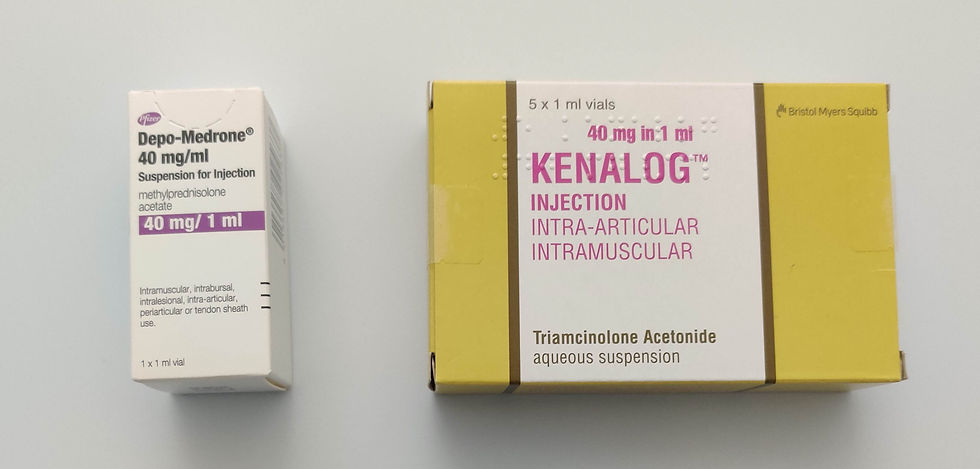Ultrasound-Guided Shoulder Steroid Injections
- Dr. Zeid Al-Ani

- Mar 1, 2023
- 3 min read
Updated: Dec 6
Steroid injection for shoulder sub-acromial bursitis
This is one of the most common ultrasound-guided treatments we perform for patients who have shoulder sub-acromial bursitis or shoulder sub-acromial impingement.

What is a bursa?
A bursa is a thin fluid-containing sac usually seen adjacent to a bone to provide cushioning effect and protection. We have a few of these within our body (like in the shoulder and hip).
What is bursitis?
Bursitis refers to inflammation of the bursa. The sub-acromial bursa is the largest in the body, located within the shoulder on top of the rotator cuff tendons. It ensures smooth movement as we lift our arms. Sub-acromial bursitis refers to inflammation of this bursa. This usually results in shoulder pain, particularly when trying to lift up your arm above the head level. Please read our article about sub-acromial bursitis to find out more.

How do steroid injections help in shoulder bursitis?
If the physiotherapy exercises are difficult to perform because of pain or not giving you adequate results, then a sub-acromial bursa steroid injection is usually indicated.
Corticosteroid (cortisone) is a potent anti-inflammatory medicine routinely used to manage inflammatory conditions (like bursitis, arthritis and tendinosis). A cortisone injection will reduce the inflammation in the bursa and allow you to manage the condition, usually by undergoing a physiotherapy program and strengthening the rotator cuff muscles.
The most commonly used type of steroid injection for subacromial bursa injection is methylprednisolone (Depo-medrone). This is a long-acting preparation that takes a few days to start working. Current evidence suggests that cortisone can improve pain and function for up to 3 months, but in some cases, it can last longer. The injections usually also contain a local anaesthetic that provides immediate pain relief lasting a few hours.
Performing these injections under ultrasound guidance is very useful as it allows for live visualisation of the needle to ensure accurate placement into the bursa at the site of inflammation. Ultrasound guidance results in more accurate, less painful and faster procedures, with better outcomes than injections without guidance.
What conditions would benefit from a shoulder sub-acromial bursa steroid injection?
A sub-acromial bursa steroid injection can be very useful in the management of:
Are steroid injections for shoulder bursitis safe?
In general, steroid injections for shoulder bursitis are very safe, with very few reported side effects and complications.
It is important that the procedure is done under ultrasound guidance to ensure injecting the medicine accurately into the bursa.
Inadvertent administration of the steroid into the adjacent rotator cuff (supraspinatus) tendon can cause tendon weakening and thus should be avoided.
Initial ultrasound assessment is very important for the same reason, as it will rule out the presence of a significant rotator cuff tear, which can be a contraindication (reason not to perform) of the injection. In this case, obtaining an opinion from a specialist shoulder surgeon would be recommended.
What are the possible complications from steroid injection for shoulder bursitis?
Shoulder sub-acromial bursa steroid injections are safe with very few reported complications. There is a very small risk of infection (1 in 10000). This is very rare as the procedure uses a very clean non-touch technique (called sterile technique). To learn more about possible complications from a steroid injection in general, please see our FAQs page.

Are shoulder bursitis injections painful?
Usually, the pain is minimal when the procedure is done under ultrasound guidance to ensure it is quick and accurate. The needle is very fine, and some do not feel the needle at all.
Will my shoulder hurt after a bursa injection?
It is reported that some people might feel pain for a few days after the injection. This is referred to as a “steroid flare”. The pain can be more if you have undergone a barbotage procedure for calcific tendonitis. Usually, resting in the area for a couple of days and avoiding strenuous activities is sufficient. Painkillers and anti-inflammatory tablets can also help control the pain until the steroid effect starts.

How many shoulder bursa steroid injections can I have?
We try to limit the number of steroid injections patients have as much as possible. Following the injection with an effective physiotherapy program will help reduce the need for a second injection. If a repeat sub-acromial bursa steroid injection is being considered, it should be at least 3-4 months from the last injection.
For more information about shoulder conditions that can be managed with a steroid injection, please see shoulder steroid injection.
Shoulder conditions and treatments


































